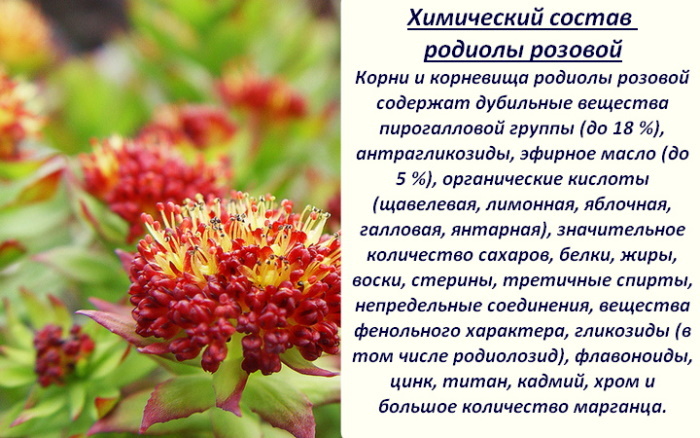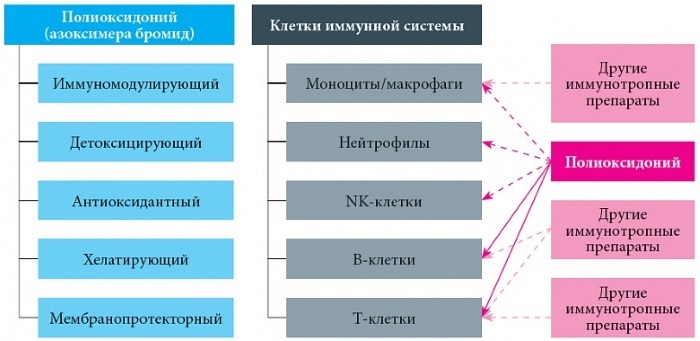Content
- Views
- Stages and degrees
- Symptoms
- Reasons for the appearance
- Diagnostics
- When to see a doctor
- Prophylaxis
- Treatment methods
- Medications
- Traditional methods
- Other methods
- Possible complications
- Appendicitis video
Appendicitis - a condition, which requires urgent medical attention. The disease is characterized by inflammation of the appendix of the cecum - the appendix.
In babies under 1 year old, the inflammatory process rarely occurs, most often it develops in children after 10 years. In this case, the symptoms of the disease may differ. According to statistics, classic signs are observed in 30% of patients. In other cases, the course of the pathology is atypical.
Views
The inflammatory process can be acute or chronic. The first case is characterized by the sudden onset of an attack with a very rapid development. In the second, the child may complain of abdominal pain for several weeks, but this form of pathology is rare in childhood.
The acute form of the disease is classified into:
- simple (catarrhal) - a mild inflammatory process without complications;
- phlegmonous, which is characterized by enlargement, ulceration and suppuration of the appendix;
- gangrenous, resulting from vascular thrombosis. This leads to tissue necrosis, possibly the development of peritonitis;
- perforated - the most dangerous type, which is characterized by suppuration and melting of the tissues of the appendix. As a result, the contents of the appendix are released into the abdominal cavity, provoking inflammation of the peritoneum.
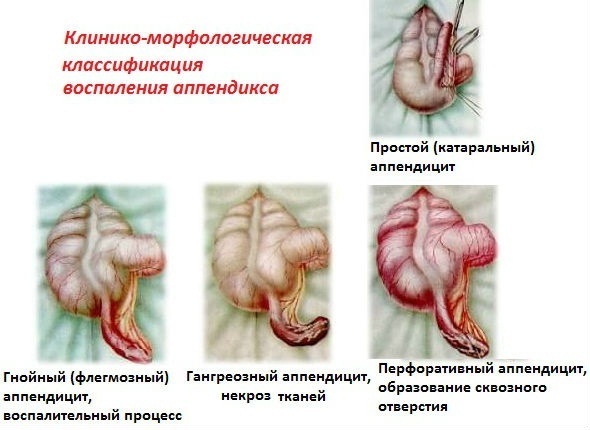
The chronic form of the disease is divided into:
- recurrent - when the inflammation periodically returns, but the symptoms are weaker;
- residual, which is characterized by the occurrence of adhesions.
The inflammatory process can be atypical:
- retrocecal, when pain is observed in the lumbar region, can be given to the thigh;
- left-sided - pain is localized on the left side of the abdomen;
- pelvic - discomfort is felt in the navel or in the lower abdomen.
Stages and degrees
Appendicitis (symptoms in children 10-13 years old depend on the severity of the inflammatory process) occurs in several stages:
- the initial one lasts about 6 hours. and is characterized by a slight thickening of the walls of the appendix. There are aching pains that cover the entire abdomen. They can be fickle and retreat periodically;
- in the second stage (phlegmonous), which lasts until the end of the first day, the appendix increases, blood thickens, which leads to the formation of blood clots;
- if assistance was not provided at the previous stage, the disease turns into a gangrenous form with the death of the walls of the organ;

- at the last stage, which is the most dangerous, there is a rupture of the appendix, and peritonitis develops. At this stage, urgent medical attention is needed.
Symptoms
Most often, an acute form of the disease occurs in childhood. Its signs appear 12 hours after the development of the pathological process.
Appendicitis (symptoms in children 10 years of age and older usually coincide with signs of pathology in adults) can manifest itself:
- pain in the abdomen. Most often, the discomfort is localized at the bottom right. But since in children the appendix is often located in an atypical place, the discomfort can cover the entire abdomen, and sometimes give to the lower back. The child tries to move less, takes a position in which the pain is felt less - on the right side with tucked legs or on the back. Painful sensations intensify during walking, coughing, change of body position. The inflammatory process is characterized by constant pain, they can only change their intensity, but do not go through to the end. Depending on the location of the appendix, the nature of pain may change:
- with a low location of the organ, aching pains occur in the pubic area;
- if the appendix is located behind the cecum, the discomfort is localized in the lumbar region, in the lower right abdomen;
- when the organ is located behind the peritoneum, pain is observed in the lower back, given to the genitals or thigh;
- lethargy, fever. In most cases, the disease manifests itself as a sharp rise in temperature up to 38 ° C. With the rapid development of pathology with complications, the indicators of the thermometer can rise to 40 ° C. If the destruction of the tissues of the organ has begun, the temperature decreases, the pressure drops and the pulse quickens;
- rapid deterioration of the condition. If purulent inflammation occurs, the baby's skin may turn pale, he suffers from thirst. With the development of peritonitis, intense pain occurs.
With the development of the pathological process, pain in the child may increase. But it also happens that the pain subsides.
This is not a sign of recovery, on the contrary, such a symptom should alert, as it indicates the transition of pathology to a gangrenous form. In this case, the nerve endings of the organ die off, which leads to a feeling of relief and a decrease in pain.
But discomfort in the abdomen is replaced by signs of general intoxication: the child becomes weak, vomiting appears, which does not bring relief, but the temperature can remain normal. A characteristic sign of the development of the inflammatory process is a white coating on the root of the tongue.
Reasons for the appearance
The reasons for the development of pathology are not fully understood. There are several theories, but they do not have sufficient confirmation.
According to the mechanical theory, inflammation of the appendix occurs due to blockage of its lumen by fecal stones, parasites, foreign objects, with its further infection.
Other factors can contribute to the development of pathology:
- decrease in protective forces. It is difficult for a child's body to cope with pathogenic microorganisms, which contributes to the penetration of infection into the abdominal cavity and the development of inflammation;
- anomalies in the structure of the appendix - twists, bends;
- frequent colds, tonsillitis, caries. It is believed that the lymphoid tissue of the appendix is also involved in the fight against such pathologies, which is trying to take the blow on itself, which ends in inflammation.
The risk of developing the disease increases with:
- insufficient fiber intake;
- overeating;
- an increased amount of sugar in the diet;
- helminthic invasions;
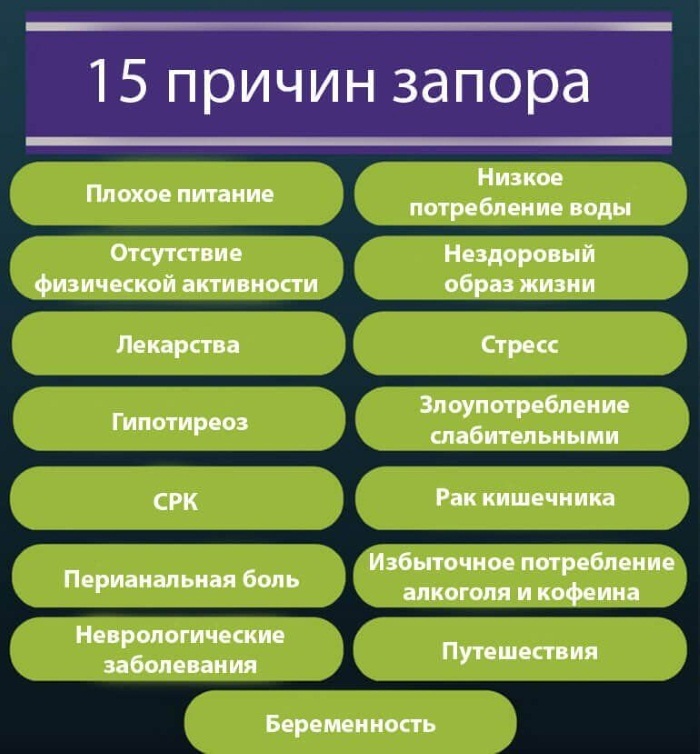
Appendicitis in children provokes constipation - frequent constipation.
Diagnostics
Appendicitis is diagnosed in a hospital setting. The difficulty is that the localization of the appendix in children 10 years old may be atypical, and the symptoms that arise may be provoked by other pathologies of the digestive system that do not require urgent surgical treatment.
First, the doctor examines the child and palpates the abdomen, prescribes a general blood test, which will show inflammation. Then it is recommended to conduct an ultrasound examination (from 1200 rubles). In this case, additional preparatory measures are not needed. The specialist uses an abdominal probe to apply light pressure to the appendix area.
Pathology is determined by:
- thickening of the walls of the organ (more than 3 mm.);
- an increase in its diameter (more than 7 mm.);
- increased echogenicity;
- inflammation of the omentum.
To obtain reliable information, an ultrasound examination should be carried out by a pediatric specialist who is well familiar with the features of the abdominal organs in children.
If the results of the study are ambiguous, it may be necessary to conduct computed tomography (from 2800 rubles) or magnetic resonance imaging (from 4000 rubles), which have a high sensitivity. In the process of diagnosis, the expansion of the lumen of the appendix is determined, the thickening of its walls.
It is also possible to carry out laparoscopy (from 16,000 rubles). During the study, an optical device is introduced through punctures in the abdominal wall, which makes it possible to assess the state of the abdominal cavity from the inside. The advantage of the method is that the inflamed appendix can be removed immediately during the procedure.
Appendicitis (symptoms in children 10 and older may be atypical) sometimes cannot be diagnosed even based on signs and test results. In this case, observational tactics can be used. The doctor monitors the symptoms over time and, based on the results, makes a diagnosis.
It is important to make a differential diagnosis with other diseases that have similar symptoms.
Differential diagnosis of appendicitis with acute intestinal infections: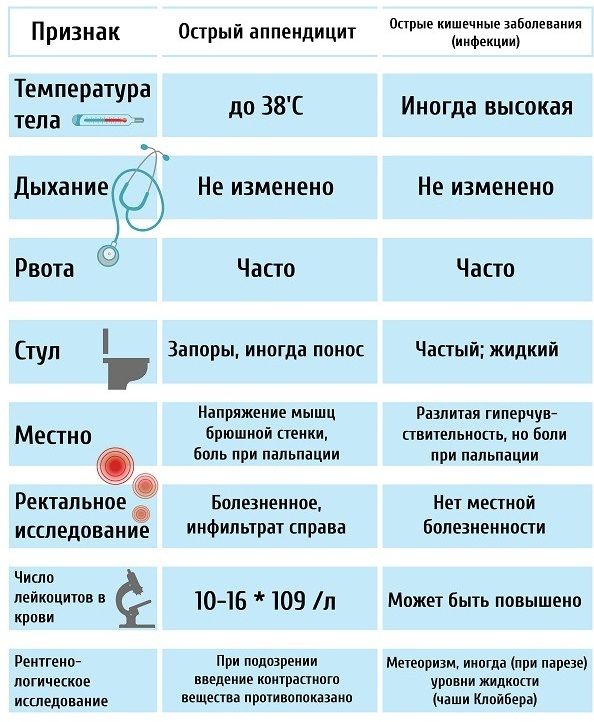
| Symptom | Acute appendicitis | Acute intestinal infection |
| Temperature | Up to 38 ° С | Sometimes increased |
| Breath | Not changed | |
| Vomit | Often | |
| Chair | Constipation or diarrhea | Frequent, runny |
| Local symptoms | Stiffness of the muscles of the abdominal wall | Diffuse hypersensitivity, tenderness to palpation |
| Leukocytes in the blood | 10-16 * 109 / l | Increase possible |
When to see a doctor
If the abdominal pain has not gone away after 2-3 hours, other symptoms have joined, it is necessary to visit a pediatric surgeon as soon as possible. If the baby is in serious condition, you need to call an ambulance.
Before the arrival of doctors, you must:
- provide the child with bed rest;
- if vomiting appears, drink small portions of liquid. This will help prevent dehydration;
- to reduce pain, apply cold to the stomach.
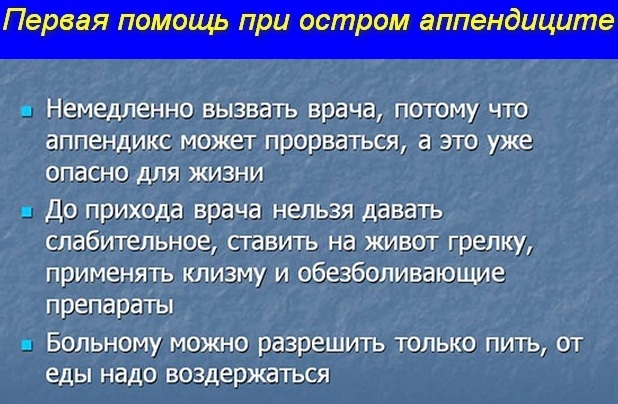
It is strictly forbidden to:
- warm the sore spot. This contributes to the rapid development of the inflammatory process;
- give pain relievers. Symptoms will be blurry, making it difficult to make a diagnosis;
- give an enema or laxative for constipation. This leads to increased pressure in the area of inflammation;
- try to force feed.
Prophylaxis
Since the causes of the development of pathology have not been precisely established, then recommendations for prevention will be general.
You can reduce the likelihood of developing the disease by:
- proper nutrition;
- prevention of constipation;
- timely therapy of infectious and inflammatory diseases.
Treatment methods
Therapy of the disease in an acute form is carried out only by surgical methods. During the intervention, the appendix is completely removed.
An appendectomy can be:
- classical - cavity intervention through an incision in the abdomen;
- laparoscopic - endoscopic intervention, which is carried out through a small puncture in the abdominal wall.
The choice of the method of operation is influenced by the location of the appendix, the stage of pathology. Laparoscopic surgery is less traumatic. With it, soft tissues are slightly damaged, and there is no massive blood loss. The recovery period does not last long.
After the classic surgery, the child can stay in the hospital for up to 10 days. It is written out after removing the stitches, which is carried out in a separate treatment room. After that, for another 2 weeks, excessive physical activity, sudden movements should be avoided, as this can lead to seam divergence.
Surgery is performed under general anesthesia. The patient is in a state of medication sleep from the very beginning of the procedure to the end. If there are contraindications, local anesthesia may be used.
After the operation, the child is placed in a separate ward and his condition is carefully monitored. A very important point is the way out of anesthesia, which can proceed in different ways. Sometimes this period is accompanied by vomiting, so the baby should lie on its side to prevent aspiration of vomit.
In the postoperative period, the patient is prescribed antibacterial agents and pain relievers. After a few hours, it is allowed to drink some plain water. Compotes, broths can be consumed in 24 hours.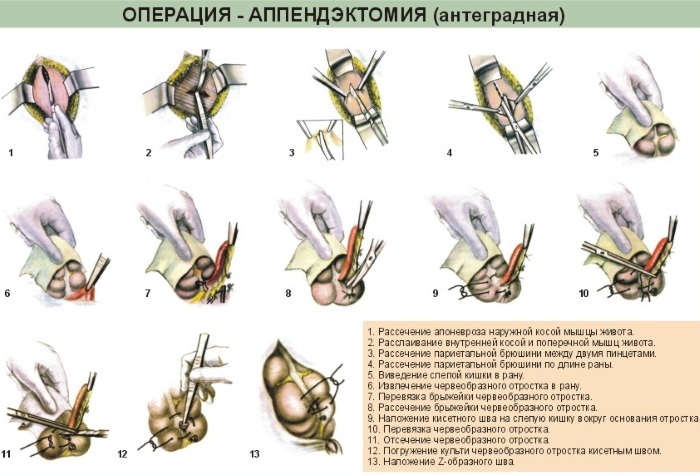
On the second day after the intervention, the use of low-fat fermented milk products, liquid cereals is allowed. For 21 days after surgery, you must adhere to a diet.
Allowed use:
- boiled fish or meat;
- dried bread;
- light soups;
- baked apples;
- weak tea.
It is necessary to exclude from the diet products that increase gas formation, start fermentation processes and irritate the mucous membrane.
After two days, the child will be allowed to get up and move, but not too actively. It is recommended that you do some simple breathing exercises to avoid lung congestion. 4-5 days after the operation, it is necessary to re-take a blood test and conduct a control ultrasound.
In the postoperative period, an increase in temperature is observed. If after 2 days it returns to normal, then there is no reason to worry. This is how the body reacts to the intervention. But if the indicators of the thermometer are increased for more than 7 days, then this may be a sign of inflammation of the peritoneum. It is also necessary to be on the alert if the temperature suddenly rises after being discharged home.
Painful sensations that did not go away a week after discharge are also an alarming symptom. In this case, it is urgent to show the child to the doctor. Such a sign may indicate that adhesions have begun to form.
Short walks are allowed 2 weeks after the child has been discharged home. When a strong scar has formed, you can visit the pool, but before that you should consult a specialist.
Medical gymnastics is also necessary, which will help to avoid complications in the postoperative period. You can do the simplest exercises, such as lying down, doing leg raises, flexion and extension.
The child is allowed to attend school within a week after he is discharged home. But at the same time, he is exempted from physical education for 1 month.
Medications
To avoid the addition of infection in the postoperative period, antibiotics are prescribed, which must be taken 1-2 days after laparoscopy and from 5 to 7 days after the classic intervention:
- Zinacef - a new generation antibacterial agent, effective against most pathogenic microorganisms. Injected 3-4 times a day. The daily dose is 30–100 mg / kg (from 152 rubles);
- Dalatsin - effective against bacteria that provoke purulent-inflammatory processes. Prescribed at a dosage of 8-25 mg per 1 kg of body weight. Frequency rate of admission - 2-4 times a day (from 845 rubles);
- Imipenem. Recommended for severe appendicitis when other antibiotics are ineffective. Administered at 15 mg / kg 4 times a day (from 667 rubles).
Uncomplicated appendicitis in childhood can be treated conservatively, according to research from the UK. But first of all, it must be confirmed by ultrasound that the appendix is not perforated.
Further, intravenous administration of rehydration agents is recommended until nausea and vomiting disappear. After that, antibacterial drugs of a wide spectrum of action are introduced. Pain relievers try not to use so as not to mask the symptoms.
If after 2 days the signs of pathology disappear, the little patient is sent home and prescribed antibiotics in tablets for 10 days, then you need to visit a doctor. According to studies, complications do not arise after such therapy; in 97% of cases, the problem is completely solved. In a small proportion of patients, inflammation develops again.
However, scientists at the moment refrain from recommending to treat appendicitis with antibacterial drugs, instead of surgical interventions, since the experiments were carried out on a small number of patients, therefore the results obtained do not make it possible to consider such way reliable.
Traditional methods
Some patients, with suspicion of appendicitis and the occurrence of pain, try to solve the problem with the help of alternative methods. It is strictly forbidden to use such methods of treatment, especially when it comes to a child.
If any symptoms indicating an inflammatory process appear, it is necessary to urgently call a doctor or go to a medical facility.
Other methods
Appendicitis can only be treated with surgery. The use of pain relievers, alternative medicine and other methods is unacceptable. The result of such actions can be a rupture of the appendix, which will lead to the ingress of pus into the abdominal cavity. And this may even end in death.
Possible complications
Appendicitis (symptoms in children 10-13 years old cannot be ignored) only in very rare cases can go away without treatment. In this case, the walls of the intestine, enveloping the inflamed process, prevent the development of infection. After the disappearance of the inflammatory process, the position of the intestinal walls may not change, provoking the appearance of spasms from time to time.
But usually without therapy, inflammation begins to progress, which leads to the occurrence of:
- appendicular infiltrate;
- abscess;
- peritonitis.

The infiltrate is formed 3-5 days after the onset of inflammation. Neighboring organs are involved in the pathological process. Further, an abscess (purulent inflammation) develops. The most dangerous complication is diffuse peritonitis.
It arises as a result of:
- migratory inflammation;
- breakthrough of the wall of the appendix;
- purulent inflammation of the abdominal organs.
If the treatment of a 10-13-year-old child with appendicitis is started in a timely manner, then the prognosis is favorable. Surgical intervention completely solves the problem, and complications in children after such therapy are rare.
The main thing is not to waste time by spending it on the use of folk methods, enemas and gastric lavages when symptoms of malaise in the baby occur. Parents should understand that self-medication can result in very dangerous consequences.
Appendicitis video
Malysheva about appendicitis in children:

